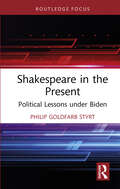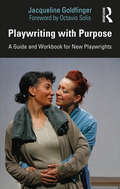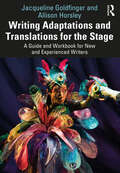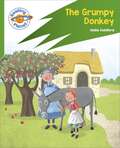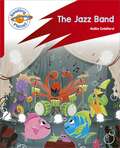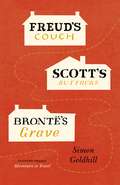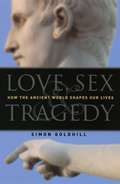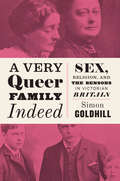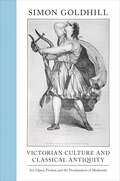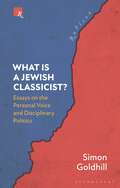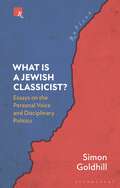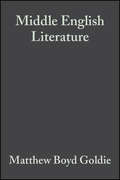- Table View
- List View
Unexpected Affinities: Modern American Poetry and Symbolist Poetics
by Lisa GoldfarbThe book studies the impact of Stevensian and Valeryan poetics, and symbolist poetics more broadly, on a range of Anglo-American poets in untypical fashion. Pairing poets who are not usually studied in their relation to one another reveals mutuality and dissimilitude. Chapter I looks at Stevens and Valery from the vantage point of the senses as opposed to the more usual lens of their similar cerebral or philosophical temperaments. Although critics have largely and justifiably seen Stevens and Eliot in oppositional terms (Stevens proclaims them dead opposites), Lisa Goldfarb asks what happens when we look at them from the vantage point of their mutual interest in creating a musical poetics. Auden is principally known for his distaste for the symbolists and their magical poetics, yet he reserves special praise for Valery and considers him as his poetic mentor; Chapter III studies their poetics side-by-side. With Stevens and Audens mutual appreciation of Valery as a starting point, Chapter IV turns to a closer comparative study of Auden and Stevens, two poets who have traditionally been seen as operating in distinct poetic spheres. While Elizabeth Bishop famously eludes categorization in terms of poetic school or affiliation, a fifth chapter addresses her poetic music in relation to French symbolist poetics, one of the many poetic schools she admired. A sixth and final chapter examines Stevens musical legacy, in large part derived from the symbolists, and addresses the work of a range of modern and contemporary poets, with a final section devoted to the work of contemporary poet, Susan Howe.
Shakespeare in the Present: Political Lessons under Biden (Routledge Focus on Literature)
by Philip Goldfarb StyrtShakespeare in the Present: Political Lessons under Biden is the first case study in applying the lessons of Shakespeare’s plays to post-Trump America. It looks at American politics through the lens of Shakespeare, not simply equating figures in the contemporary world to Shakespearean characters, but showing how the broader conditions of Shakespeare’s imagined worlds reflect and inform our own. Clearly written, in a direct and engaging style, it shows that reading Shakespeare with our contemporary Washington in mind can enrich our understanding of both his works and our world. Shakespeare wrote for his own time, but we always read him in our present. As such, the way we read him now is always affected by our own understanding of our own political world. This book provides quick critical analyses of Shakespeare’s plays and contemporary American politics while serving as an introduction for undergraduates and general readers to this kind of topical, presentist criticism of Shakespeare.
Shakespeare in the Present: Political Lessons under Biden (Routledge Focus on Literature)
by Philip Goldfarb StyrtShakespeare in the Present: Political Lessons under Biden is the first case study in applying the lessons of Shakespeare’s plays to post-Trump America. It looks at American politics through the lens of Shakespeare, not simply equating figures in the contemporary world to Shakespearean characters, but showing how the broader conditions of Shakespeare’s imagined worlds reflect and inform our own. Clearly written, in a direct and engaging style, it shows that reading Shakespeare with our contemporary Washington in mind can enrich our understanding of both his works and our world. Shakespeare wrote for his own time, but we always read him in our present. As such, the way we read him now is always affected by our own understanding of our own political world. This book provides quick critical analyses of Shakespeare’s plays and contemporary American politics while serving as an introduction for undergraduates and general readers to this kind of topical, presentist criticism of Shakespeare.
Playwriting with Purpose: A Guide and Workbook for New Playwrights
by Jacqueline GoldfingerPlaywriting with Purpose: A Guide and Workbook for New Playwrights provides a holistic approach to playwriting from an award-winning playwright and instructor. This book incorporates craft lessons by contemporary playwrights and provides concrete guidance for new and emerging playwrights. The author takes readers through the entire creative process, from creating characters and writing dialogue and silent moments to analyzing elements of well-made plays and creating an atmospheric environment. Each chapter is followed by writing prompts and pro tips that address unique facets of the conversation about the art and craft of playwriting. The book also includes information on the business of playwriting and a recommended reading list of published classic and contemporary plays, providing all the tools to successfully transform an idea into a script, and a script into a performance. Playwriting with Purpose gives writers and students of playwriting hands-on lessons, artistic concepts, and business savvy to succeed in today’s theater industry.
Playwriting with Purpose: A Guide and Workbook for New Playwrights
by Jacqueline GoldfingerPlaywriting with Purpose: A Guide and Workbook for New Playwrights provides a holistic approach to playwriting from an award-winning playwright and instructor. This book incorporates craft lessons by contemporary playwrights and provides concrete guidance for new and emerging playwrights. The author takes readers through the entire creative process, from creating characters and writing dialogue and silent moments to analyzing elements of well-made plays and creating an atmospheric environment. Each chapter is followed by writing prompts and pro tips that address unique facets of the conversation about the art and craft of playwriting. The book also includes information on the business of playwriting and a recommended reading list of published classic and contemporary plays, providing all the tools to successfully transform an idea into a script, and a script into a performance. Playwriting with Purpose gives writers and students of playwriting hands-on lessons, artistic concepts, and business savvy to succeed in today’s theater industry.
Writing Adaptations and Translations for the Stage: A Guide and Workbook for New and Experienced Writers
by Jacqueline Goldfinger Allison HorsleyWriting Adaptations and Translations for the Stage is a practical guide for writing adapted works for theatrical performance.Broadway translator and dramaturg Allison Horsley and award-winning playwright and educator Jacqueline Goldfinger take readers step-by-step through the brainstorming, writing, revision, and performance processes for translations and adaptations. The book includes lectures, case studies, writing exercises, and advice from top theater professionals on the process of creating, pitching, and producing adaptations and translations, covering a wide range of topics such as jukebox musicals, Shakespeare adaptations, plays from novels, theater for young adults, and theater in translation and using Indigenous language. Artists who share their wisdom in this book include: Des McAnuff (Tony Award), Emily Mann (Tony Award), Dominique Morisseau (Broadway Adaptor, Tony Award nominee, MacArthur Genius Fellow), Lisa Peterson (Obie Award, Lortel Award), Sarah Ruhl (Broadway Playwright, Tony Award nominee, Pulitzer Prize finalist, MacArthur Genius Fellow), and Tina Satter (Broadway Director, Obie Award, Guggenheim Fellowship). The book also features interviews with artists working both in the US and internationally, as well as guest columns from artists who work in less traditional adaptive forms including cabaret, burlesque, opera, community-engaged process, and commercial theater.Writing Adaptations and Translations for the Stage is an essential resource for students and instructors of Dramatic Writing, Playwriting, and Creative Writing courses and for aspiring playwrights.
Writing Adaptations and Translations for the Stage: A Guide and Workbook for New and Experienced Writers
by Jacqueline Goldfinger Allison HorsleyWriting Adaptations and Translations for the Stage is a practical guide for writing adapted works for theatrical performance.Broadway translator and dramaturg Allison Horsley and award-winning playwright and educator Jacqueline Goldfinger take readers step-by-step through the brainstorming, writing, revision, and performance processes for translations and adaptations. The book includes lectures, case studies, writing exercises, and advice from top theater professionals on the process of creating, pitching, and producing adaptations and translations, covering a wide range of topics such as jukebox musicals, Shakespeare adaptations, plays from novels, theater for young adults, and theater in translation and using Indigenous language. Artists who share their wisdom in this book include: Des McAnuff (Tony Award), Emily Mann (Tony Award), Dominique Morisseau (Broadway Adaptor, Tony Award nominee, MacArthur Genius Fellow), Lisa Peterson (Obie Award, Lortel Award), Sarah Ruhl (Broadway Playwright, Tony Award nominee, Pulitzer Prize finalist, MacArthur Genius Fellow), and Tina Satter (Broadway Director, Obie Award, Guggenheim Fellowship). The book also features interviews with artists working both in the US and internationally, as well as guest columns from artists who work in less traditional adaptive forms including cabaret, burlesque, opera, community-engaged process, and commercial theater.Writing Adaptations and Translations for the Stage is an essential resource for students and instructors of Dramatic Writing, Playwriting, and Creative Writing courses and for aspiring playwrights.
Reading Planet: Rocket Phonics – Target Practice - The Grumpy Donkey - Green
by Hallie GoldfordLily Sprout lives on her family's farm where she helps feed the animals and look after the crops. When a new donkey named Drew arrives at the farm, Lily is worried as he seems so sad and grumpy. Grandma agrees and asks her nephew, Matthew, who has lots of donkeys, for advice. Can Matthew help cheer Drew up? (Letter-sounds featured: long /oo/ -ew /y+oo/ ew) The Grumpy Donkey is part of the Rocket Phonics systematic synthetic phonics programme from Reading Planet. Rocket Phonics ensures that every child achieves phonics success. This fully-decodable Target Practice reading book provides focused practice of a small group of letter-sounds. The book also includes useful notes and activities to support reading in school and at home as well as comprehension questions to check understanding. Reading age: 5-6.
Reading Planet: Rocket Phonics – Target Practice - The Jazz Band - Red A
by Hallie GoldfordMax and Yaz get tickets to see a live jazz band. The exciting thing about the show is that it's underwater! The two friends swim and clap to the music. Find out which sea creatures are playing in the band. (Letter-sounds featured: w x y z zz) The Jazz Band is part of the Rocket Phonics systematic synthetic phonics programme from Reading Planet. Rocket Phonics ensures that every child achieves phonics success. This fully-decodable Target Practice reading book provides focused practice of a small group of letter-sounds. The book also includes useful notes and activities to support reading in school and at home as well as comprehension questions to check understanding. Reading age: 4-5/Reception
Freud's Couch, Scott's Buttocks, Brontë's Grave: Adventures In Travel: Freud's Couch, Scott's Buttocks, Bronte's Grave (Culture Trails: Adventures in Travel)
by Simon GoldhillThe Victorian era was the high point of literary tourism. Writers such as Charles Dickens, George Eliot, and Sir Walter Scott became celebrities, and readers trekked far and wide for a glimpse of the places where their heroes wrote and thought, walked and talked. Even Shakespeare was roped in, as Victorian entrepreneurs transformed quiet Stratford-upon-Avon into a combination shrine and tourist trap. Stratford continues to lure the tourists today, as do many other sites of literary pilgrimage throughout Britain. And our modern age could have no better guide to such places than Simon Goldhill. In Freud's Couch, Scott’s Buttocks, Brontë's Grave, Goldhill makes a pilgrimage to Sir Walter Scott's baronial mansion, Wordsworth's cottage in the Lake District, the Bront ë parsonage, Shakespeare's birthplace, and Freud's office in Hampstead. Traveling, as much as possible, by methods available to Victorians—and gamely negotiating distractions ranging from broken bicycles to a flock of giggling Japanese schoolgirls—he tries to discern what our forebears were looking for at these sites, as well as what they have to say to the modern mind. What does it matter that Emily Brontë’s hidden passions burned in this specific room? What does it mean, especially now that his fame has faded, that Scott self-consciously built an extravagant castle suitable for Ivanhoe—and star-struck tourists visited it while he was still living there? Or that Freud's meticulous recreation of his Vienna office is now a meticulously preserved museum of itself? Or that Shakespeare’s birthplace features student actors declaiming snippets of his plays . . . in the garden of a house where he almost certainly never wrote a single line? Goldhill brings to these inquiries his trademark wry humor and a lifetime's engagement with literature. The result is a travel book like no other, a reminder that even today, the writing life still has the power to inspire.
Freud's Couch, Scott's Buttocks, Brontë's Grave (Culture Trails: Adventures in Travel)
by Simon GoldhillThe Victorian era was the high point of literary tourism. Writers such as Charles Dickens, George Eliot, and Sir Walter Scott became celebrities, and readers trekked far and wide for a glimpse of the places where their heroes wrote and thought, walked and talked. Even Shakespeare was roped in, as Victorian entrepreneurs transformed quiet Stratford-upon-Avon into a combination shrine and tourist trap. Stratford continues to lure the tourists today, as do many other sites of literary pilgrimage throughout Britain. And our modern age could have no better guide to such places than Simon Goldhill. In Freud's Couch, Scott’s Buttocks, Brontë's Grave, Goldhill makes a pilgrimage to Sir Walter Scott's baronial mansion, Wordsworth's cottage in the Lake District, the Bront ë parsonage, Shakespeare's birthplace, and Freud's office in Hampstead. Traveling, as much as possible, by methods available to Victorians—and gamely negotiating distractions ranging from broken bicycles to a flock of giggling Japanese schoolgirls—he tries to discern what our forebears were looking for at these sites, as well as what they have to say to the modern mind. What does it matter that Emily Brontë’s hidden passions burned in this specific room? What does it mean, especially now that his fame has faded, that Scott self-consciously built an extravagant castle suitable for Ivanhoe—and star-struck tourists visited it while he was still living there? Or that Freud's meticulous recreation of his Vienna office is now a meticulously preserved museum of itself? Or that Shakespeare’s birthplace features student actors declaiming snippets of his plays . . . in the garden of a house where he almost certainly never wrote a single line? Goldhill brings to these inquiries his trademark wry humor and a lifetime's engagement with literature. The result is a travel book like no other, a reminder that even today, the writing life still has the power to inspire.
Freud's Couch, Scott's Buttocks, Brontë's Grave (Culture Trails: Adventures in Travel)
by Simon GoldhillThe Victorian era was the high point of literary tourism. Writers such as Charles Dickens, George Eliot, and Sir Walter Scott became celebrities, and readers trekked far and wide for a glimpse of the places where their heroes wrote and thought, walked and talked. Even Shakespeare was roped in, as Victorian entrepreneurs transformed quiet Stratford-upon-Avon into a combination shrine and tourist trap. Stratford continues to lure the tourists today, as do many other sites of literary pilgrimage throughout Britain. And our modern age could have no better guide to such places than Simon Goldhill. In Freud's Couch, Scott’s Buttocks, Brontë's Grave, Goldhill makes a pilgrimage to Sir Walter Scott's baronial mansion, Wordsworth's cottage in the Lake District, the Bront ë parsonage, Shakespeare's birthplace, and Freud's office in Hampstead. Traveling, as much as possible, by methods available to Victorians—and gamely negotiating distractions ranging from broken bicycles to a flock of giggling Japanese schoolgirls—he tries to discern what our forebears were looking for at these sites, as well as what they have to say to the modern mind. What does it matter that Emily Brontë’s hidden passions burned in this specific room? What does it mean, especially now that his fame has faded, that Scott self-consciously built an extravagant castle suitable for Ivanhoe—and star-struck tourists visited it while he was still living there? Or that Freud's meticulous recreation of his Vienna office is now a meticulously preserved museum of itself? Or that Shakespeare’s birthplace features student actors declaiming snippets of his plays . . . in the garden of a house where he almost certainly never wrote a single line? Goldhill brings to these inquiries his trademark wry humor and a lifetime's engagement with literature. The result is a travel book like no other, a reminder that even today, the writing life still has the power to inspire.
Freud's Couch, Scott's Buttocks, Brontë's Grave: Adventures In Travel: Freud's Couch, Scott's Buttocks, Bronte's Grave (Culture Trails: Adventures in Travel)
by Simon GoldhillThe Victorian era was the high point of literary tourism. Writers such as Charles Dickens, George Eliot, and Sir Walter Scott became celebrities, and readers trekked far and wide for a glimpse of the places where their heroes wrote and thought, walked and talked. Even Shakespeare was roped in, as Victorian entrepreneurs transformed quiet Stratford-upon-Avon into a combination shrine and tourist trap. Stratford continues to lure the tourists today, as do many other sites of literary pilgrimage throughout Britain. And our modern age could have no better guide to such places than Simon Goldhill. In Freud's Couch, Scott’s Buttocks, Brontë's Grave, Goldhill makes a pilgrimage to Sir Walter Scott's baronial mansion, Wordsworth's cottage in the Lake District, the Bront ë parsonage, Shakespeare's birthplace, and Freud's office in Hampstead. Traveling, as much as possible, by methods available to Victorians—and gamely negotiating distractions ranging from broken bicycles to a flock of giggling Japanese schoolgirls—he tries to discern what our forebears were looking for at these sites, as well as what they have to say to the modern mind. What does it matter that Emily Brontë’s hidden passions burned in this specific room? What does it mean, especially now that his fame has faded, that Scott self-consciously built an extravagant castle suitable for Ivanhoe—and star-struck tourists visited it while he was still living there? Or that Freud's meticulous recreation of his Vienna office is now a meticulously preserved museum of itself? Or that Shakespeare’s birthplace features student actors declaiming snippets of his plays . . . in the garden of a house where he almost certainly never wrote a single line? Goldhill brings to these inquiries his trademark wry humor and a lifetime's engagement with literature. The result is a travel book like no other, a reminder that even today, the writing life still has the power to inspire.
Love, Sex & Tragedy: How the Ancient World Shapes Our Lives (Women In Culture And Society Ser.)
by Simon Goldhill"If you do not know where you come from, you will always be a child." Cicero wasn't talking about being a child in the sense of enjoying life in a state of ignorant bliss. He was, rather, adamant that those who don't understand their origins are consigned to a life without power or authority, without the ability to act fully in the world. Love, Sex & Tragedy is acclaimed classicist Simon Goldhill's corrective to our state of ignorance. Lifting the veil on our inheritance of classical traditions, Goldhill offers a witty, engrossing survey of the Greek and Roman roots of everything from our overwhelming mania for "hard bodies" to our political systems. Marx, Clark Gable, George W. Bush, Oscar Wilde, and Freud—Goldhill's range here is enormous, and he takes great delight in tracing both follies and fundamental philosophical questions through the centuries and continents to the birthplace of Western civilization as we know it. Underlying his brisk and learned excursions through history and art is the foundational belief, following Cicero, that learning about the classics makes a critical difference to our self-understanding. Whether we are considering the role of religion in contemporary society, our expectations about the boundaries between public and private life, or even how we spend our free time, recognizing the role of the classics is integral to our comprehension of modern life and our place in it. When Goldhill asks "Who do you think you are?" he presents us with the rarest of opportunities: the chance to let him lead us, firmly but with a wink, back two thousand years to where we are.
A Very Queer Family Indeed: Sex, Religion, and the Bensons in Victorian Britain
by Simon Goldhill“We can begin with a kiss, though this will not turn out to be a love story, at least not a love story of anything like the usual kind.” So begins A Very Queer Family Indeed, which introduces us to the extraordinary Benson family. Edward White Benson became Archbishop of Canterbury at the height of Queen Victoria’s reign, while his wife, Mary, was renowned for her wit and charm—the prime minister once wondered whether she was “the cleverest woman in England or in Europe.” The couple’s six precocious children included E. F. Benson, celebrated creator of the Mapp and Lucia novels, and Margaret Benson, the first published female Egyptologist. What interests Simon Goldhill most, however, is what went on behind the scenes, which was even more unusual than anyone could imagine. Inveterate writers, the Benson family spun out novels, essays, and thousands of letters that open stunning new perspectives—including what it might mean for an adult to kiss and propose marriage to a twelve-year-old girl, how religion in a family could support or destroy relationships, or how the death of a child could be celebrated. No other family has left such detailed records about their most intimate moments, and in these remarkable accounts, we see how family life and a family’s understanding of itself took shape during a time when psychoanalysis, scientific and historical challenges to religion, and new ways of thinking about society were developing. This is the story of the Bensons, but it is also more than that—it is the story of how society transitioned from the high Victorian period into modernity.
A Very Queer Family Indeed: Sex, Religion, and the Bensons in Victorian Britain
by Simon Goldhill“We can begin with a kiss, though this will not turn out to be a love story, at least not a love story of anything like the usual kind.” So begins A Very Queer Family Indeed, which introduces us to the extraordinary Benson family. Edward White Benson became Archbishop of Canterbury at the height of Queen Victoria’s reign, while his wife, Mary, was renowned for her wit and charm—the prime minister once wondered whether she was “the cleverest woman in England or in Europe.” The couple’s six precocious children included E. F. Benson, celebrated creator of the Mapp and Lucia novels, and Margaret Benson, the first published female Egyptologist. What interests Simon Goldhill most, however, is what went on behind the scenes, which was even more unusual than anyone could imagine. Inveterate writers, the Benson family spun out novels, essays, and thousands of letters that open stunning new perspectives—including what it might mean for an adult to kiss and propose marriage to a twelve-year-old girl, how religion in a family could support or destroy relationships, or how the death of a child could be celebrated. No other family has left such detailed records about their most intimate moments, and in these remarkable accounts, we see how family life and a family’s understanding of itself took shape during a time when psychoanalysis, scientific and historical challenges to religion, and new ways of thinking about society were developing. This is the story of the Bensons, but it is also more than that—it is the story of how society transitioned from the high Victorian period into modernity.
A Very Queer Family Indeed: Sex, Religion, and the Bensons in Victorian Britain
by Simon Goldhill“We can begin with a kiss, though this will not turn out to be a love story, at least not a love story of anything like the usual kind.” So begins A Very Queer Family Indeed, which introduces us to the extraordinary Benson family. Edward White Benson became Archbishop of Canterbury at the height of Queen Victoria’s reign, while his wife, Mary, was renowned for her wit and charm—the prime minister once wondered whether she was “the cleverest woman in England or in Europe.” The couple’s six precocious children included E. F. Benson, celebrated creator of the Mapp and Lucia novels, and Margaret Benson, the first published female Egyptologist. What interests Simon Goldhill most, however, is what went on behind the scenes, which was even more unusual than anyone could imagine. Inveterate writers, the Benson family spun out novels, essays, and thousands of letters that open stunning new perspectives—including what it might mean for an adult to kiss and propose marriage to a twelve-year-old girl, how religion in a family could support or destroy relationships, or how the death of a child could be celebrated. No other family has left such detailed records about their most intimate moments, and in these remarkable accounts, we see how family life and a family’s understanding of itself took shape during a time when psychoanalysis, scientific and historical challenges to religion, and new ways of thinking about society were developing. This is the story of the Bensons, but it is also more than that—it is the story of how society transitioned from the high Victorian period into modernity.
A Very Queer Family Indeed: Sex, Religion, and the Bensons in Victorian Britain
by Simon Goldhill“We can begin with a kiss, though this will not turn out to be a love story, at least not a love story of anything like the usual kind.” So begins A Very Queer Family Indeed, which introduces us to the extraordinary Benson family. Edward White Benson became Archbishop of Canterbury at the height of Queen Victoria’s reign, while his wife, Mary, was renowned for her wit and charm—the prime minister once wondered whether she was “the cleverest woman in England or in Europe.” The couple’s six precocious children included E. F. Benson, celebrated creator of the Mapp and Lucia novels, and Margaret Benson, the first published female Egyptologist. What interests Simon Goldhill most, however, is what went on behind the scenes, which was even more unusual than anyone could imagine. Inveterate writers, the Benson family spun out novels, essays, and thousands of letters that open stunning new perspectives—including what it might mean for an adult to kiss and propose marriage to a twelve-year-old girl, how religion in a family could support or destroy relationships, or how the death of a child could be celebrated. No other family has left such detailed records about their most intimate moments, and in these remarkable accounts, we see how family life and a family’s understanding of itself took shape during a time when psychoanalysis, scientific and historical challenges to religion, and new ways of thinking about society were developing. This is the story of the Bensons, but it is also more than that—it is the story of how society transitioned from the high Victorian period into modernity.
A Very Queer Family Indeed: Sex, Religion, and the Bensons in Victorian Britain
by Simon Goldhill“We can begin with a kiss, though this will not turn out to be a love story, at least not a love story of anything like the usual kind.” So begins A Very Queer Family Indeed, which introduces us to the extraordinary Benson family. Edward White Benson became Archbishop of Canterbury at the height of Queen Victoria’s reign, while his wife, Mary, was renowned for her wit and charm—the prime minister once wondered whether she was “the cleverest woman in England or in Europe.” The couple’s six precocious children included E. F. Benson, celebrated creator of the Mapp and Lucia novels, and Margaret Benson, the first published female Egyptologist. What interests Simon Goldhill most, however, is what went on behind the scenes, which was even more unusual than anyone could imagine. Inveterate writers, the Benson family spun out novels, essays, and thousands of letters that open stunning new perspectives—including what it might mean for an adult to kiss and propose marriage to a twelve-year-old girl, how religion in a family could support or destroy relationships, or how the death of a child could be celebrated. No other family has left such detailed records about their most intimate moments, and in these remarkable accounts, we see how family life and a family’s understanding of itself took shape during a time when psychoanalysis, scientific and historical challenges to religion, and new ways of thinking about society were developing. This is the story of the Bensons, but it is also more than that—it is the story of how society transitioned from the high Victorian period into modernity.
A Very Queer Family Indeed: Sex, Religion, and the Bensons in Victorian Britain
by Simon Goldhill“We can begin with a kiss, though this will not turn out to be a love story, at least not a love story of anything like the usual kind.” So begins A Very Queer Family Indeed, which introduces us to the extraordinary Benson family. Edward White Benson became Archbishop of Canterbury at the height of Queen Victoria’s reign, while his wife, Mary, was renowned for her wit and charm—the prime minister once wondered whether she was “the cleverest woman in England or in Europe.” The couple’s six precocious children included E. F. Benson, celebrated creator of the Mapp and Lucia novels, and Margaret Benson, the first published female Egyptologist. What interests Simon Goldhill most, however, is what went on behind the scenes, which was even more unusual than anyone could imagine. Inveterate writers, the Benson family spun out novels, essays, and thousands of letters that open stunning new perspectives—including what it might mean for an adult to kiss and propose marriage to a twelve-year-old girl, how religion in a family could support or destroy relationships, or how the death of a child could be celebrated. No other family has left such detailed records about their most intimate moments, and in these remarkable accounts, we see how family life and a family’s understanding of itself took shape during a time when psychoanalysis, scientific and historical challenges to religion, and new ways of thinking about society were developing. This is the story of the Bensons, but it is also more than that—it is the story of how society transitioned from the high Victorian period into modernity.
Victorian Culture and Classical Antiquity: Art, Opera, Fiction, and the Proclamation of Modernity
by Simon GoldhillHow did the Victorians engage with the ancient world? Victorian Culture and Classical Antiquity is a brilliant exploration of how the ancient worlds of Greece and Rome influenced Victorian culture. Through Victorian art, opera, and novels, Simon Goldhill examines how sexuality and desire, the politics of culture, and the role of religion in society were considered and debated through the Victorian obsession with antiquity. Looking at Victorian art, Goldhill demonstrates how desire and sexuality, particularly anxieties about male desire, were represented and communicated through classical imagery. Probing into operas of the period, Goldhill addresses ideas of citizenship, nationalism, and cultural politics. And through fiction--specifically nineteenth-century novels about the Roman Empire--he discusses religion and the fierce battles over the church as Christianity began to lose dominance over the progressive stance of Victorian science and investigation. Rediscovering some great forgotten works and reframing some more familiar ones, the book offers extraordinary insights into how the Victorian sense of antiquity and our sense of the Victorians came into being. With a wide range of examples and stories, Victorian Culture and Classical Antiquity demonstrates how interest in the classical past shaped nineteenth-century self-expression, giving antiquity a unique place in Victorian culture.
Victorian Culture and Classical Antiquity: Art, Opera, Fiction, and the Proclamation of Modernity
by Simon GoldhillHow did the Victorians engage with the ancient world? Victorian Culture and Classical Antiquity is a brilliant exploration of how the ancient worlds of Greece and Rome influenced Victorian culture. Through Victorian art, opera, and novels, Simon Goldhill examines how sexuality and desire, the politics of culture, and the role of religion in society were considered and debated through the Victorian obsession with antiquity. Looking at Victorian art, Goldhill demonstrates how desire and sexuality, particularly anxieties about male desire, were represented and communicated through classical imagery. Probing into operas of the period, Goldhill addresses ideas of citizenship, nationalism, and cultural politics. And through fiction--specifically nineteenth-century novels about the Roman Empire--he discusses religion and the fierce battles over the church as Christianity began to lose dominance over the progressive stance of Victorian science and investigation. Rediscovering some great forgotten works and reframing some more familiar ones, the book offers extraordinary insights into how the Victorian sense of antiquity and our sense of the Victorians came into being. With a wide range of examples and stories, Victorian Culture and Classical Antiquity demonstrates how interest in the classical past shaped nineteenth-century self-expression, giving antiquity a unique place in Victorian culture.
What Is a Jewish Classicist?: Essays on the Personal Voice and Disciplinary Politics (Rubicon)
by Simon GoldhillIn recent years, there has been no issue that has convulsed academia and its role in society more stridently than the personal politics of its institutions: who has access to education? How does who you are change what you study and how you engage with it? How does scholarship reflect the politics of society – how should it? These new essays from one of the best-known scholars of ancient Greece offer a refreshing and provocative contribution to these discussions. What is a Jewish Classicist? analyses how the personal voice of a scholar plays a role in scholarship, how religion and cultural identity are acted out within an academic discipline, and how translation, the heart of any engagement with the literature of antiquity, is a transformational practice. Topical, engaging, revelatory, this book opens a sharp and personal perspective on how and why the study of antiquity has become such a battlefield in contemporary culture. The first essay looks at how academics can and should talk about themselves, and how such positionality affects a scholar's work – can anyone can tell his or her own story with enough self-consciousness, sophistication and care? The second essay, which gives the book its title, takes a more socio-anthropological approach to the discipline, and asks how its patterns of inclusion and exclusion, its strategies of identification and recognition, have contributed to the shape of the discipline of classics. This initial enquiry opens into a fascinating history of change – how Jews were excluded from the discipline for many years but gradually after the Second World war became more easily assimilated into it. This in turn raises difficult questions for the current focus on race and colour as the defining aspects of personal identification, and about how academia reflects or contributes to the broader politics of society. The third essay takes a different historical approach and looks at the infrastructure or technology of the discipline through one of its integral and time-honoured practices, namely, translation. It discusses how translation, far from being a mere technique, is a transformational activity that helps make each classicist what they are. Indeed, each generation needs its own translations as each era redefines its relation to antiquity.
What Is a Jewish Classicist?: Essays on the Personal Voice and Disciplinary Politics (Rubicon)
by Simon GoldhillIn recent years, there has been no issue that has convulsed academia and its role in society more stridently than the personal politics of its institutions: who has access to education? How does who you are change what you study and how you engage with it? How does scholarship reflect the politics of society – how should it? These new essays from one of the best-known scholars of ancient Greece offer a refreshing and provocative contribution to these discussions. What is a Jewish Classicist? analyses how the personal voice of a scholar plays a role in scholarship, how religion and cultural identity are acted out within an academic discipline, and how translation, the heart of any engagement with the literature of antiquity, is a transformational practice. Topical, engaging, revelatory, this book opens a sharp and personal perspective on how and why the study of antiquity has become such a battlefield in contemporary culture. The first essay looks at how academics can and should talk about themselves, and how such positionality affects a scholar's work – can anyone can tell his or her own story with enough self-consciousness, sophistication and care? The second essay, which gives the book its title, takes a more socio-anthropological approach to the discipline, and asks how its patterns of inclusion and exclusion, its strategies of identification and recognition, have contributed to the shape of the discipline of classics. This initial enquiry opens into a fascinating history of change – how Jews were excluded from the discipline for many years but gradually after the Second World war became more easily assimilated into it. This in turn raises difficult questions for the current focus on race and colour as the defining aspects of personal identification, and about how academia reflects or contributes to the broader politics of society. The third essay takes a different historical approach and looks at the infrastructure or technology of the discipline through one of its integral and time-honoured practices, namely, translation. It discusses how translation, far from being a mere technique, is a transformational activity that helps make each classicist what they are. Indeed, each generation needs its own translations as each era redefines its relation to antiquity.
Middle English Literature: A Historical Sourcebook
by Matthew Boyd GoldieThis collection of fourteenth- and fifteenth-century documents is designed for students of Chaucer and Middle English literature. It makes readily available accounts of key historical events and descriptions of pertinent cultural phenomena. Brings together in one volume fourteenth- and fifteenth-century historical and cultural texts. Documents shed light on the themes and styles that appear in Chaucer and other Middle English literature. Contains twelve important images from the period. Concise introductions and bibliographies accompany all documents.

